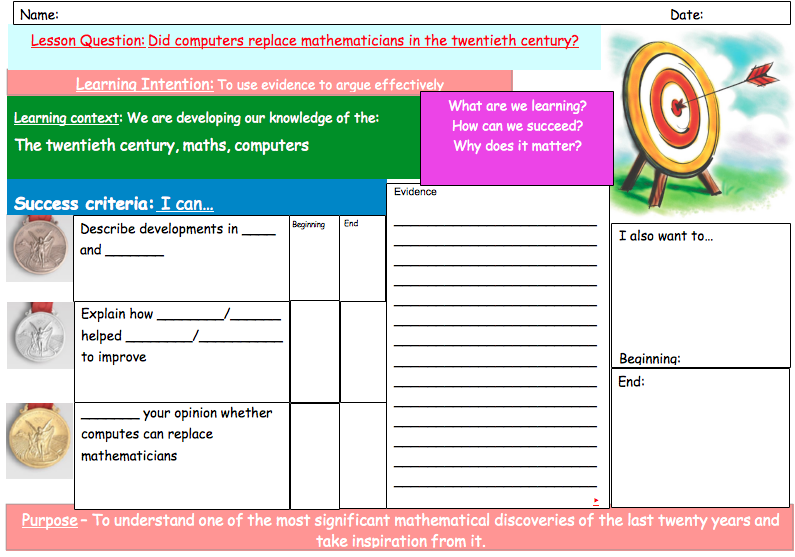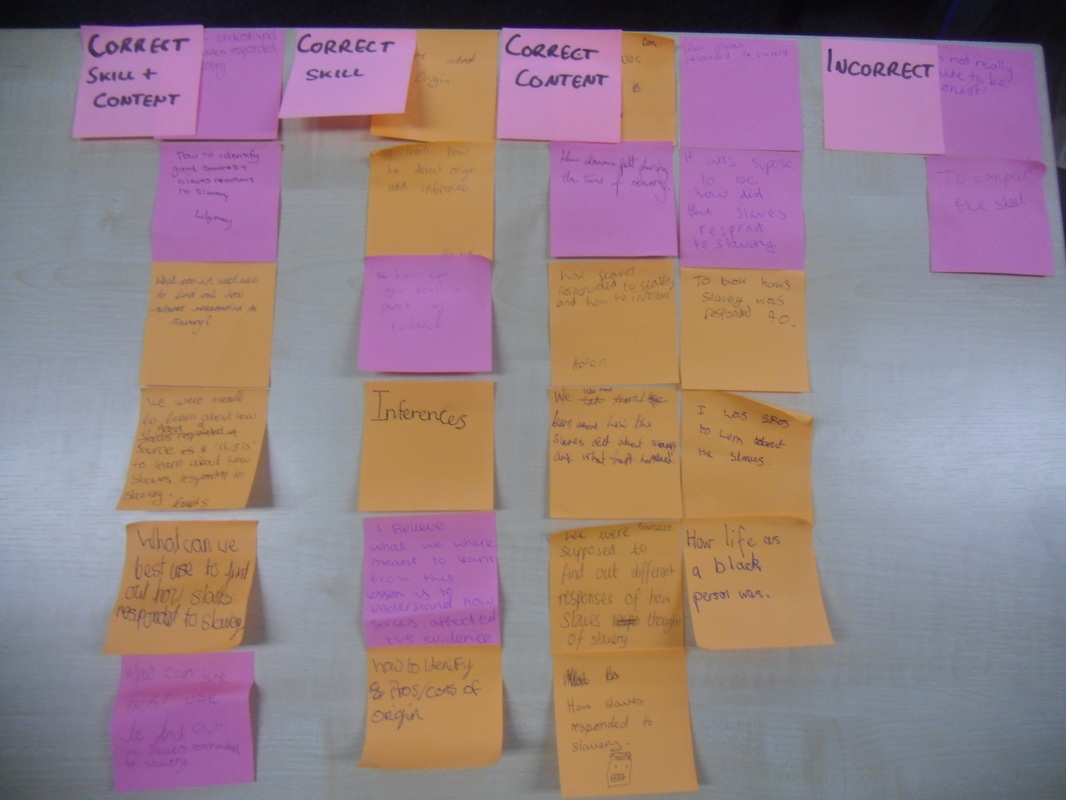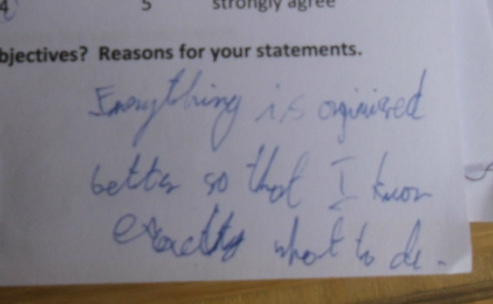Stephen Covey introduces Habit 2 of ‘The Seven Habits of Highly Effective People’ with the arresting invitation to the reader to visualise their own funeral. With a family member, a friend, a colleague and a community member to speak, he asks “What would you like each speaker to say about you and your life?”
This is used to introduce the habit of beginning with the end in mind, on the understanding that awareness of our direction fundamentally changes how we approach everything we do:
To begin with the end in mind means to start with a clear understanding of your destination. It means to know where you’re going so that you better understand where you are now and so that the steps you take are always in the right direction.”
Sharing what Dylan Wiliam terms ‘learning intentions’ is a pillar of Assessment for Learning, for similar reasons. Having explored the theory, I was aware that it is important to share learning intentions; I also knew that there were many ways in which my technique in this area could be improved. Influenced by Alex Quigley’s writing on deliberate practice, I spent much of last term seeking this improvement. I experimented with a single class, going through a number of iterations, reflecting upon each and refining accordingly: this post summarises the process and the results.
The medium I chose to use was a sheet for every lesson. After numerous changes, the format I have settled upon is this:
(Downloadable as a word document here: 7- 33- Analysis intentions)
Why does it look like this?
Much remained unchanged from what I had been doing previously – students guessed missing words to ensure that a degree of comprehension and engagement on their part, the lesson was organised around a question, the purpose of the lesson was highlighted and I used ‘bronze,’ ‘silver’ and ‘gold’ objectives – designed to motivate without pre-judging students’ potential for success.
The changes were:
- I split the learning intention (using evidence to argue effectively) from the learning context (computers, maths and the twentieth century) – but then reintegrated them in the success criteria.
- I asked students to guess the missing words; once we had corrected their guesses, students put a ‘tick, squiggle or cross’ at the beginning of the lesson, depending on their assessment of their current competency on that objective.
- Students added their own learning objective, which would fit into the lesson question (an idea from Ms Findlater, whose presentation on this at a Teachmeet caught me in the middle of trying to improve my work on learning intentions – her post on this is well worth a read) as a way to offer them a degree of ownership and engagement in the lesson while maintaining my overall control of the direction it took.
- Mindful of Dylan Wiliam’s presentation of research suggesting the limitations and inaccuracies of self-assessment, at the end of the lesson I allotted about two minutes for students to tick, squiggle or cross in the ‘End’ boxes, depending on how they perceived their progress and also asked students to provide evidence for their self-assessment, which I could then review. (What they wrote I left to them, suggesting that they might explain what they now understood or give an example of this understanding, or, indeed, explain why they had not understood something).
Steps along the way…
These photos show some highlights of the first half term working on this. Click on any photo to view them as a gallery. I’ve added further comments below.
1) I gained clearer evidence of students’ progress within lessons. Pictures 3 and 6 are particularly clear examples of evidence of students’ progress and next steps.
2) This provided a strong basis for student self-evaluation and understanding of next steps: 3 and 8 show this -demonstrating good understanding of how to get better in history.
3) This approach worked for a range of students (Pictures 4 and 6).
4) I was forced to reflect more deeply about how I used learning objectives and how they met with the lesson: 2 is a clear example of my having to rethink, but equally, on reflection, I realised 6 and 7, the highest learning objective is a bit of a stupid question for a history lesson – thankfully, in their answers, students have focussed on whether or not computers did replace them – not can.
Did it work?
This survey was from a lesson designed to offer students an insight into the responses of slaves to slavery while also developing their skill in handling evidence.
Six students were totally correct: “What can we best used to find out how slaves responded to slavery?” “We were meant to learn about how good a source ‘this is’ to learn about how slaves responded to slavery,” “How to identify good sources and slaves reactions to slavery.”
The remaining two columns were both entirely accurate and well-phrased, but either focused on the responses of slaves or on the handling of evidence.
Six students offered correct responses with a focus on skills: “inference,” “how to detect origin and inference,” “how can you trust a piece of evidence.”
Eleven students offered correct responses with a focus on knowledge: “To know how slavery was responded to” “We learned about how slaves responded to slavery and what happened”
Only two students gave incorrect answers: “To complete the sheet” and the admirably truthful: “I’m not really sure to be honest.”
This is substantially better than the quality of answers before I began this experiment – giving me confidence that the overwhelming majority had a good understanding of the lesson’s purpose. However, it still leaves a number of questions, which I’ll address below.
Did students appreciate the change?
I surveyed 20 students from the class with whom I had been experimenting. I asked them to answer a series of questions on a scale from 1 (strongly disagree) to 5 (strongly agree).
11 students agreed or strongly agreed they understood what they were meant to be doing better (none disagreed).
16 agreed or strongly agreed that they understood better the progress they were making.
13 agreed or strongly agreed they had more control over their learning (only one disagreed)
14 agreed or strongly agreed they felt more motivated (10 strongly so)
13 preferred this approach (four did not – see below in the negative comments for some thoughts on why this might be).
- I understand better because it’s not just one person doing the thing on the board it’s everyone
- I think we should do this from now on because it gets me into the mood and to get me prepared for the lesson ahead of me
- I think this because I understand the work, am able to see my progress, can take control and remember things and I like doing objectives on the board because it’s easier.
- I will be able to look back at it if I am stuck in the lessons to get back on track
- Making people guess it engages them
- We do a lot of thinking in class
- This way we have a chance to say something instead of some people saying things
- Everything is organised better so that I know exactly what to do
- I think this way is fun and always will be
Negative comments mainly focused around my requirement students hung on to and were able to retrieve the sheet:
- Because I keep on losing the LO too much fuss
- Too much writing and I always lose it and spend ages searching
- When we all do it as a class I feel more interacted [sic] and more focused
Since we’ve moved from having one folder for all subjects to subject-specific folders this year, this should be less of an issue.
Evaluation
The benefits of pursuing this were:
Students have gained a better understanding of the direction of lessons and what they should be doing. By challenging students to actually take in and use the learning objectives and to connect this with their their existing knowledge and their understanding at the end of the lesson, the lesson’s aims became clearer. For example, one lesson I asked students at the beginning of the lesson how many of them believed they had already met one of the learning objectives and was surprised to see almost half the class indicated they already knew something about Industrial Revolution mathematicians at the beginning of the lesson. Questioning them, I reduced this to one student swiftly, who was able to describe elements of Babbage’s work. This helped students understand what “being able to describe the work of Industrial Revolution mathematicians” looked like and hence the aim of the lesson.
Students meta-cognition has improved alongside this (one student’s epiphany came last week: “So, are the questions linked to the bronze, silver and gold learning objectives!)”
A fringe benefit, or perhaps just an observation, is that students had no problem stating how well they were doing and what progress they had made in a lesson. There was no embarrassment in saying they had not reached the highest success criterion, for example. I think this is a function of both the climate for learning in the class and of an assessment model which is not heavily reported and level-focussed. Had there been a more explicit summative function of the sheet, I would be surprised if it were so useful or so honestly filled in.
Students are more responsible for tracking and explaining their own progress. This is implicit in the process – students must understand the lesson objective (not just letting it happen at the front of the class) in order to respond at the beginning. They cannot fake this, because they will be asked to give evidence to prove their understanding at the end of the lesson.
I have gained a better understanding of the direction of lessons and what progress looks like. Firstly, I was forced to reconsider my success criteria and how appropriate and well-chosen they were. By implication, I then had to think about how well my activities built towards these aims. Clearly, a good teacher should be doing this for every single lesson, but bringing the learning intentions to the forefront of my mind and the students’ work and then considering whether or not the lesson provided the time or opportunity to meet the learning objectives, forced me to this far more thoughtfully and rigorously, and I’ve sustained this since.
Students have a clear record of each lesson, in terms of the success criteria and their achievements. This provides an easy ready-reference in future lessons and an enforced, additional conclusion to the lesson.
I can more easily check the progress students have made. I can skim a class’s worth of these and make brief annotations and comments in ten minutes and get a good overview of students’ perceptions of their progress and understandings.
Limitations
1) What am I going to do about the students who still don’t ‘get’ the learning intentions? (OK, it was only two in my most recent check – but how is that acceptable?)
2) How am I going to make it more student-led? Students are increasingly able to guess the missing words correctly, but some days, where the starter is something worth taking time over, it would be good to be able to hand out this sheet and enable some students to start on them and even continue to the main task of the lesson while others are still puzzling.
3) Is there enough differentiation to the top? I certainly have a raft of possible ways to push students beyond the gold objective – and I don’t want more than three objectives on any one sheet, particularly while the first learning objective remains a challenge for some students. Perhaps this links with (2) and, when I next return to improve my use of learning intentions, I need to further consider how students can set their own objectives in line with the direction of the lesson.
Conclusions:
I was asked recently whether the time invested in the learning intentions is worthwhile. It takes up little more time than my previous method, but I am far more confident that students understand what they should be learning in each lesson, the progress they are making and what more they should be doing. I’m also far better at setting and thinking through learning intentions myself. This experiment was certainly a good investment of my time and my students.
What happens next?
I have been trialling this with one class in their history lessons. I now need to roll this out to the other classes. One of the strengths of starting individually has been checking lesson objective sheets every time I’ve used them. This has partly been to help me understand how students are using them; it is also because this is a way to ensure they are filling in the sheets as I would like them to. In the long run I wouldn’t seek to read every sheet every time (other AfL techniques like hinge questions should be telling me this anyway). However, I will need to reinforce how they are used, so there’s an issue around scaling up. I would probably look to take a sample on a regular basis for quality assurance and so ondoing this with everyone, lots of paper (but in folders)
I still need to keep thinking through the disentangling of knowledge and skills – or the practicality of this.
Postscript, October
I first wrote this in about May. I have tinkered and tinkered and decided, rather than embarking on yet another total rewrite, just to add a postscript to note that:
– I’ve rolled this out with all my classes from last year and all the Year 7s who have joined the school since. Although I’m carrying around an awful lot of paper, it provides a clear system and a neat way to ensure they have a record of each lesson – and a top and tail to each lesson. The speed with which the Year 7s have learned to respond to these suggests I’ve got better at formulating and explaining what’s happening- although there’s still plenty of room for improvement- a topic I shall leave for another day.
– I also changed the purpose bit to ‘So that’ which helped me tighten up the phrasing I used in the subsequent sentence.
Further reading on learning objectives:
My previous posts on why learning intentions matter and how we can share them.
Sarah Findlater has collected (curated?) a series of posts on sharing learning intentions in one place here.
She also has a great selection of ideas on learning objectives of her own.
Zoe Elder’s post on the ‘so that,’ demonstrating the purpose of learning is important.
Gray and Tall’s forbiddingly titled ‘Duality, Ambiguity and Flexibility: A Proceptual View of Simple Arithmetic’ provides some of the the research on which this is built – a tricky read, but worth it!
And of course Dylan Wiliam’s book, Embedded Formative Assessment introduces the whole thing with some ideas on how to go about it.














Reblogged this on The Echo Chamber.
This has given me lots to think about! Integrating skills and knowledge effectively is tricky and a one size fits all solution doesn’t cater for students’ needs at different ends of the ability spectrum
I think the question of differentiating objectives well is possibly the biggest thing to consider when I have another go at improving this – it hadn’t occurred to me but I think you’re right to link the two issues. Lots to think about for me too!
Reblogged this on paddington teaching and learning and commented:
A brilliant piece of reflective practice in action here -remodelling how you share learning intentions and lesson objectives, and then sensitively measuring the impact.